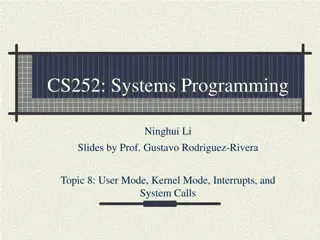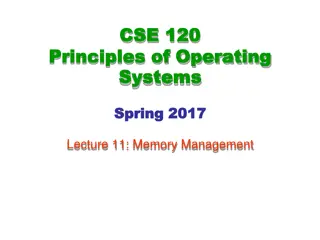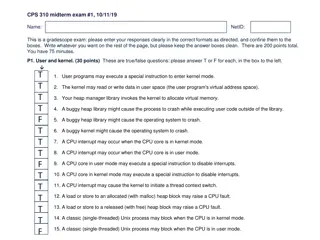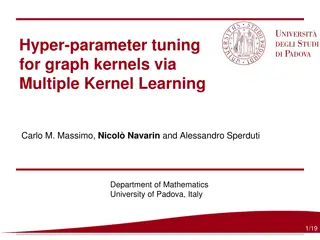Kernel and User Virtual Memory
Explore the concept of kernel and user virtual memory in Linux operating systems, including demand paging, memory allocation mechanisms, physical memory mappings, and traditional memory mapping strategies. Learn about the mapping of virtual memory at system boot time, differences between kernel and user virtual memory, and the translation of physical addresses to kernel virtual addresses.
Download Presentation

Please find below an Image/Link to download the presentation.
The content on the website is provided AS IS for your information and personal use only. It may not be sold, licensed, or shared on other websites without obtaining consent from the author.If you encounter any issues during the download, it is possible that the publisher has removed the file from their server.
You are allowed to download the files provided on this website for personal or commercial use, subject to the condition that they are used lawfully. All files are the property of their respective owners.
The content on the website is provided AS IS for your information and personal use only. It may not be sold, licensed, or shared on other websites without obtaining consent from the author.
E N D
Presentation Transcript
Kernel Memory Chris Gill, David Ferry, Brian Kocoloski, James Orr, Marion Sudvarg CSE 422S - Operating Systems Organization Washington University in St. Louis St. Louis, MO 63130 1
Kernel vs User Virtual Memory When page tables are filled in on-demand like this, this is referred to as demand paging By default, Linux uses demand paging for all user processes Keeps memory allocation (virtual, i.e., malloc()) fast Doesn t allocate physical memory until process tries to access it However, kernel virtual memory is always pre- paged When the system boots, all physical memory is mapped into the kernel virtual address space CSE 422S Operating Systems Organization 2
Kernel vs User Virtual Memory Kernel Virtual Memory User Virtual Memory Physical Memory Mappings created at runtime via memory allocation (e.g., mmap()) and page fault handling Mappings created at system boot time CSE 422S Operating Systems Organization 3
Traditional Memory Mapping Strategy in Linux (on x86_64) Virtual Memory Mappings created at system boot time Kernel address space Physical Memory CSE 422S Operating Systems Organization 4
Traditional Memory Mapping Strategy in Linux (on x86_64) Virtual Memory Mappings created at system boot time User address space Mappings created at runtime via memory allocation (e.g., mmap()) and page fault handling Kernel address space Physical Memory CSE 422S Operating Systems Organization 5
Traditional Memory Mapping Strategy in Linux (on x86_64) Virtual Memory Green VA are free Blue VA are allocated User address space But, both area always mapped in the kernel s page tables Kernel address space Physical Memory CSE 422S Operating Systems Organization 6
Physical to Virtual Translation Given a physical address, how do I calculate the kernel virtual address to access it? __va(unsigned long pa); On arm 7 (R Pi 3): ((unsigned long)((x) - PHYS_OFFSET + PAGE_OFFSET)) PHYS_OFFSET: first address of physical memory PAGE_OFFSET: (On our 32-bit R Pis) 0x80000000 The point is, reverse PA->VA translation can be done in O(1) time CSE 422S Operating Systems Organization 7
Dynamic Management of Kernel Memory Page level management Use alloc_pages() and free_pages() etc. Object level management Use kmalloc() and kfree() etc. (virtually and physically contiguous) Use vmalloc() and vfree() etc. (only virtually contiguous ) Slab allocation Use kmem_cache_create() and then kmem_cache_alloc() and kmem_cache_free() etc. for each distinct type of memory object CSE 422S Operating Systems Organization 8
Vmalloc vs Kmalloc Kmalloc: virtually and physically contiguous Vmalloc: only virtually contiguous What does virtually contiguous mean? int * ar = kmalloc(sizeof(int) * 100, GFP_KERNEL) printf( %p , ar); If value of ar is X, then the virtual address range [X, X+sizeof(int)*100) stores the array contents CSE 422S Operating Systems Organization 9
Vmalloc vs Kmalloc kmalloc() returns virtually and physically contiguous addresses i.e., Assume we want to allocate S bytes of memory Assume X is the return value (virtual address) from a call to kmalloc(S) Assume pa(X) = Y Then, for all every byte x from 0 to S, PA(x) = Y+x CSE 422S Operating Systems Organization 10
Traditional Memory Mapping Strategy in Linux (on x86_64) Virtual Memory Assume green VA are free Assume blue VA are allocated Kernel address space Physical Memory Calls to kmalloc() effectively search through green VA space to find free virtual address space CSE 422S Operating Systems Organization 11
Vmalloc vs Kmalloc vmalloc() returns only virtually contiguous addresses i.e Assume we want to allocate S bytes of memory Assume X is the return value (virtual address) from a call to vmalloc(S) Assume pa(X) = Y Then, for all every byte x from 0 to PAGE_SIZE-1, PA(X+x) = Y+x But what about byte x=PAGE_SIZE? Assume PA(X+PAGE_SIZE) = Z Could be that Z=Y+PAGE_SIZE But, could be a completely different physical address Z CSE 422S Operating Systems Organization 12
Traditional Memory Mapping Strategy in Linux (on x86_64) Virtual Memory Assume blue VA are allocated Calls to vmalloc() effectively allocate new, previously unused virtual address space, and map it to possibly discontiguous memory Kernel address space Physical Memory New vmalloc() d memory CSE 422S Operating Systems Organization 13
Page Level Management (Pre-)allocating larger chunks of memory E.g., 2n contiguous pages: alloc_pages(GFP_KERNEL, n) Each page is fixed size (usually 4Kb or 8Kb) with enough room for hundreds of individual objects Can request a page with filled-in values Use get_zeroed_page() to hide previous contents Must free pages once finished using them Use free_page() if a single page was allocated Use free_pages() if multiple were allocated at once CSE 422S Operating Systems Organization 14
Object Level Management Size of each allocation is in bytes I.e., the size of the object being allocated Rather than the number of fixed-sized pages Kernel version of malloc: kmalloc() and kfree() Action modifiers (can/cannot sleep, etc.) Zone modifiers (DMA, DMA32, HIGH, NORMAL) Type flags: combine action and zone modifiers Allocated memory is physically contiguous Virtually contiguous memory Though not necessarily physically contiguous Use vmalloc() and vfree() etc. CSE 422S Operating Systems Organization 15
Kernel Memory Trade-Offs Page level management Coarse granularity, low performance overhead Object level management Finer granularity, higher performance overhead By default, prefer the kmalloc() version over the vmalloc() version, for performance Slab allocation Optimizes performance if allocating and de- allocating large numbers of the same kind of object CSE 422S Operating Systems Organization 16
Other Kernel Memory Options Static allocation on the stack Can be risky, as stacks are limited to 1 or 2 pages In general, minimize stack usage by design By default, use the kernel allocation techniques previously discussed instead of stack allocation Per-CPU allocation Think of this as core-specific storage Can improve cache performance, reduce contention Must disable kernel preemption (per-CPU interface does) Must alloc and put per-CPU data (like alloc/free) CSE 422S Operating Systems Organization 17























